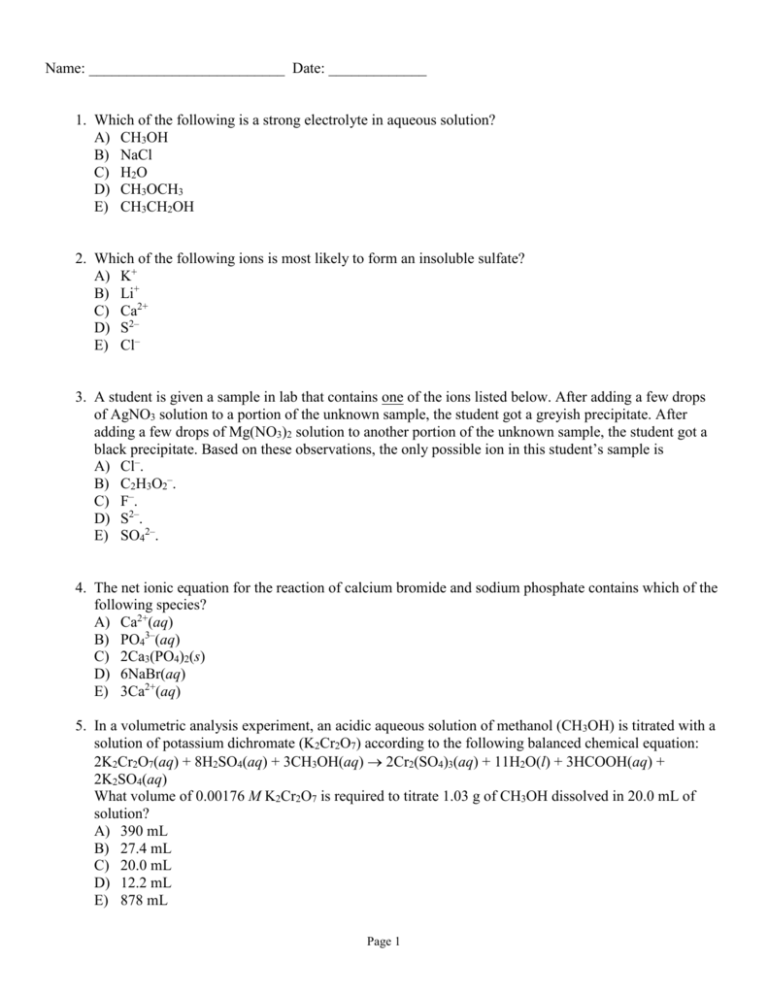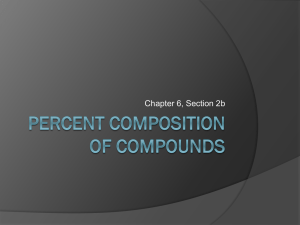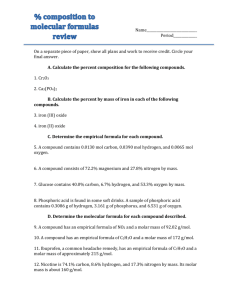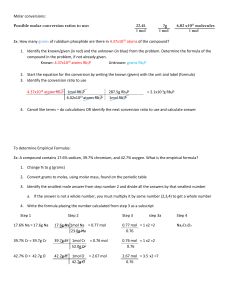chm 1045
advertisement

Name: __________________________ Date: _____________ 1. Which of the following is a strong electrolyte in aqueous solution? A) CH3OH B) NaCl C) H2O D) CH3OCH3 E) CH3CH2OH 2. Which of the following ions is most likely to form an insoluble sulfate? A) K+ B) Li+ C) Ca2+ D) S2– E) Cl– 3. A student is given a sample in lab that contains one of the ions listed below. After adding a few drops of AgNO3 solution to a portion of the unknown sample, the student got a greyish precipitate. After adding a few drops of Mg(NO3)2 solution to another portion of the unknown sample, the student got a black precipitate. Based on these observations, the only possible ion in this student’s sample is A) Cl–. B) C2H3O2–. C) F–. D) S2–. E) SO42–. 4. The net ionic equation for the reaction of calcium bromide and sodium phosphate contains which of the following species? A) Ca2+(aq) B) PO43–(aq) C) 2Ca3(PO4)2(s) D) 6NaBr(aq) E) 3Ca2+(aq) 5. In a volumetric analysis experiment, an acidic aqueous solution of methanol (CH3OH) is titrated with a solution of potassium dichromate (K2Cr2O7) according to the following balanced chemical equation: 2K2Cr2O7(aq) + 8H2SO4(aq) + 3CH3OH(aq) 2Cr2(SO4)3(aq) + 11H2O(l) + 3HCOOH(aq) + 2K2SO4(aq) What volume of 0.00176 M K2Cr2O7 is required to titrate 1.03 g of CH3OH dissolved in 20.0 mL of solution? A) 390 mL B) 27.4 mL C) 20.0 mL D) 12.2 mL E) 878 mL Page 1 6. The reaction of HCl with NaOH is represented by the equation HCl(aq) + NaOH(aq) → NaCl(aq) + H2O(l) What volume of 0.831 M HCl is required to titrate 49.5 mL of 0.818 M NaOH? A) 49.5 mL B) 50.3 mL C) 33.6 mL D) 48.7 mL E) 1.20 mL 7. What volume of 0.54 M NaCl may be prepared by dilution of 0.100 L of a 6.0 M NaCl solution? A) 1.1 L B) 0.91 L C) 0.90 L D) 0.54 L E) 1.9 L 8. What is the reduction half-reaction for the reaction of zinc with hydrochloric acid? Zn(s) + 2H+(aq) + 2Cl–(aq) → Zn2+(aq) + 2Cl–(aq) + H2(g) A) Zn(s) → Zn2+(aq) + 2e– B) Zn(s) → Zn2+(aq) + 2Cl–(aq) + 2e– C) 2H+(aq) + 2e– → H2(g) D) 2H+(aq) + 2e– + 2Cl–(aq) → H2(g) + 2Cl–(aq) E) 2H+(aq) + 2e–(aq) → H2(g) + 2Cl–(aq) 9. All of the following reactions can be described as displacement reactions except A) Zn(s) + FeCl2(aq) → ZnCl2(aq) + Fe(s). B) CuSO4(aq) + Fe(s) → Cu(s) + FeSO4(aq). C) 2Na(s) + 2H2O(l) → 2NaOH(aq) + H2(g). D) C6H6(l) + Cl2(g) → C6H5Cl(l) + HCl(g). E) Cu(s) + 2AgNO3(aq) → Cu(NO3)2(aq) + 2Ag(s). 10. What is the balanced oxidation half-reaction for the following reaction? Cu2+(aq) + Fe(s) → Cu(s) + Fe2+(aq) A) Cu2+(aq) + 2e– → Cu(s) B) Fe2+(aq) + 2e– → Fe(s) C) Fe(s) → Fe2+(aq) + 2e– D) Cu(s) + 2e– → Cu(s) E) Cu(s) → Cu2+(aq) + 2e– Page 2 20. The empirical formula of propylene is CH3. An experimental determination of the molar mass of propylene by a student yields the value of 42 g/mol. What is the molecular formula of propylene? A) CH3 B) C3H6 C) C3H8 D) C5H10 E) C6H9 21. An atom of an element weighs 6.28 10-23 g. What is the atomic mass of this element in atomic mass units? 22. NaHCO3 is the active ingredient in baking soda. How many grams of oxygen are present in 0.78 g of NaHCO3? 23. What is the mass percentage of carbon in the compound C6H8O2? A) 64.3% B) 28.6% C) 12.5% D) 71.4% E) 7.1% 24. Calculate the number of moles of bromine present in 17.5 mL of Br2(l), whose density is 3.12 g/mL. 25. How many moles of pentane, C5H12, are contained in a 17-g sample? 26. The total number of oxygen atoms in 1.03 g of CaCO3 (MM = 100.0 g/mol) is Page 3 27. A compound has a molar mass of 180.7 g/mol and contains 53.13% oxygen atoms by mass. How many oxygen atoms are in each molecule of this compound? A) 9 B) 5 C) 8 D) 6 E) 3 28. A compound containing only carbon, hydrogen, and oxygen is subjected to elemental analysis. Upon complete combustion, a 0.4675-g sample of the compound produced 0.7905 g of CO2 and 0.3236 g of H2O. What is the empirical formula of the compound? A) CH2O3 B) C2H2O C) C4H8O3 D) C3H6O3 E) C3H3O 29. The commercial production of phosphoric acid, H3PO4, can be represented by the equation 1600 g 791 g 306 g 1150 g 280 g Ca3(PO4)2 + 3SiO2 + 5C + 5O2 + 3H2O 3CaSiO3 + 5CO2 + 2H3PO4 310 g/mol 60.1 g/mol 12.0 g/mol 32.0 g/mol 18.0 g/mol The molar mass for each reactant is shown below the reactant, and the mass of each reactant for this problem is given above. Which substance is the limiting reactant? 30. A 5.95-g sample of AgNO3 is reacted with BaCl2 according to the equation ______AgNO3 (aq) +_____ BaCl2 (aq) ____ AgCl(s) +____ Ba(NO3 )2 (aq) to give 3.69 g of AgCl. Balance the equation. Name all the compounds in this chemical reaction. What is the percent yield of AgCl? Page 4 Answer Key 1. 2. 3. 4. 5. 6. 7. 8. 9. 10. B C D E D D A C D C 20. 21. 22. 23. 24. 25. 26. 27. 28. 29. 30. B 37.8 amu 0.45 g A 0.342 mol 0.24 mol 1.86 1022. D C SiO2 73.5 % Page 5 20. The empirical formula of propylene is CH3. An experimental determination of the molar mass of propylene by a student yields the value of 42 g/mol. What is the molecular formula of propylene? A) CH3 B) C3H6 C) C3H8 D) C5H10 E) C6H9 21. An atom of an element weighs 6.28 10-23 g. What is the atomic mass of this element in atomic mass units? 22. NaHCO3 is the active ingredient in baking soda. How many grams of oxygen are present in 0.78 g of NaHCO3? 23. What is the mass percentage of carbon in the compound C6H8O2? A) 64.3% B) 28.6% C) 12.5% D) 71.4% E) 7.1% 24. Calculate the number of moles of bromine present in 17.5 mL of Br2(l), whose density is 3.12 g/mL. 25. How many moles of pentane, C5H12, are contained in a 17-g sample? 26. The total number of oxygen atoms in 1.03 g of CaCO3 (MM = 100.0 g/mol) is Page 6 27. A compound has a molar mass of 180.7 g/mol and contains 53.13% oxygen atoms by mass. How many oxygen atoms are in each molecule of this compound? A) 9 B) 5 C) 8 D) 6 E) 3 28. A compound containing only carbon, hydrogen, and oxygen is subjected to elemental analysis. Upon complete combustion, a 0.4675-g sample of the compound produced 0.7905 g of CO2 and 0.3236 g of H2O. What is the empirical formula of the compound? A) CH2O3 B) C2H2O C) C4H8O3 D) C3H6O3 E) C3H3O 29. The commercial production of phosphoric acid, H3PO4, can be represented by the equation 1600 g 791 g 306 g Ca3(PO4)2 + 3SiO2 + 5C + 310 g/mol 60.1 g/mol 1150 g 5O2 + 280 g 3H2O 3CaSiO3 + 5CO2 + 2H3PO4 12.0 g/mol 32.0 g/mol 18.0 g/mol The molar mass for each reactant is shown below the reactant, and the mass of each reactant for this problem is given above. Which substance is the limiting reactant? 30. A 5.95-g sample of AgNO3 is reacted with BaCl2 according to the equation ______AgNO3 (aq) +_____ BaCl2 (aq) ____ AgCl(s) +____ Ba(NO3 )2 (aq) to give 3.69 g of AgCl. Balance the equation. Name all the compounds in this chemical reaction. What is the percent yield of AgCl? Page 7








